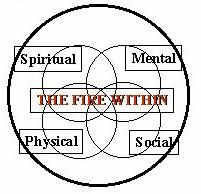of Highly Effective People
by Stephen R. Covey
THE COVEY LEADERSHIP CENTER PARADIGMS
What Is a Paradigm?
The way an individual perceives, understands, and interprets the surrounding world. A
mental map.
Human Needs: "The Fire Within" Paradigm
Human beings have natural needs they must fulfill in order to lead balanced, happy,
healthy lives. The four broad areas of human need are the physical (the need to live), the
social (the need to love), the mental (the need to learn), and the spiritual (the need to
leave a legacy). When all of a person's needs get fulfilled in a proper balance, that
person experiences a "Fire Within" that drives him forward in all his
endeavours. The following graphic illustrates this concept:



The Production/Production Capability (P/PC) Paradigm
Aesop's fable of "The Goose and the Golden Egg" offers an excellent analogy for
the balance that a person must strike between Production (P) and Production Capability
(PC). In order for the actual Production (P, or the "golden eggs") to continue
to grow and to flow, Production Capability (PC, or the "goose") must never be
sacrificed, but instead must be constantly maintained and nurtured.
The Emotional Bank Account Paradigm
This paradigm serves as a useful model for the deposits and withdrawals we make in our
human relationships. Emotional deposits include kindnesses and courtesies, while emotional
withdrawals include unkindnesses and discourtesies. Unlike a financial bank account, an
Emotional Bank Account requires continual small deposits to maintain its balance.
The Law of the Harvest Paradigm
The adage that "what you sow, so shall you reap" holds true in all areas of
life, not just farming. A set of sequential, reality-oriented, time-driven steps must be
accomplished ("sown") in order to harvest ("reap") the desired
benefits. In real life, there are no truly successful "get rich quick" schemes.
The Four-Quadrant Activity-Management Paradigm
In life, all activities can be classified into four basic categories or
"quadrants" based on two measurements: Urgency and Importance. The following
matrix illustrates how to categorize tasks based on these two criteria. Note that Quadrant
II should remain a person's primary focus when planning. Note also that people frequently
ignore Quadrant II ("fire prevention") in favor of Quadrant I ("putting out
fires") or, worse yet, the trivial activities of Quadrants III and IV.
Relationship-building is a key Quadrant II activity. An
important concept introduced by the Quadrant II focus is that of the role. In
relationships, each individual serves in a role of some sort. Examples include:
parent, employee, employer, club member, etc. The concept of the role
offers a valuable grouping and planning tool when determining what goals to set
and what tasks to perform over a given period of time.
The Organizer Generations Paradigm
Since their origins, personal time-management organizers have passed through several
generations of development:
Generation 1: Notes and checklists
Generation 2: Calendars and appointment books
Generation 3: Prioritization, clarifying values, goal-setting, daily planning
(e.g., The Franklin Day Planner)
Generation 4: Self-management, focus on Quadrant II, balancing P and PC (e.g.,
The Seven Habits Organizer)
The Covey Organizer Paradigm
The Covey Leadership Center teaches the following six-step weekly organizing process:
- Connect to Mission
- Review Roles
- Identify Goals
- Organize Weekly
- Exercise Integrity in the Moment of Choice
- Evaluate
The Seven Habits of Highly Effective People: The
"Maturity Continuum" Paradigm
The following seven habits represent objective paradigms in action. The most effective
people in the world practice these seven habits and embrace them as part of their
values systems. The "Maturity Continuum" represents how the first three
habits move a person from the dependence of a baby to the independence
of a mature adult. The "Maturity Continuum" presses onward to illustrate how the
second three habits move a mature person from mere independence forward to interdependence
with other mature people in a synergistic fashion. Finally, the "Maturity
Continuum" wraps these first six habits together with a seventh habit of continuous
improvement.
- From Dependence to Independence
- Be Proactive
- Begin with the End in Mind
- Put First Things First
- From Independence to Interdependence
- Think Win/Win
- Seek First to Understand, Then to Be Understood
- Synergize
- Continuous Improvement
- Sharpen the Saw

![]()